by Joseph C. Dean, P.E. and Steve Geusic, P.E., for the Director, Corrosion Policy & Oversight (DCPO), (DASD) [Materiel Readiness]
Updated: 04-06-2022
INTRODUCTION
Within This Page
Although, the word "corrosion" is most often associated with "rust" and the oxidation of other metals, 10 U.S.C. § 2228 defines corrosion as, "the deterioration of a material or its properties due to a reaction of that material with its chemical environment." It is inclusive of the deterioration of all materials, which can be caused through sun exposure (ultraviolet [UV] radiation and heat), mold, wind, and other environmental factors. Soil corrosivity, industrial activity contaminates (sulfides, nitrides, chlorides) and design-oriented factors (dissimilar metals, ponding, crevices, welds, inaccessible voids, material selections) also affect the extent of corrosion on utilities and structures. Environmental Severity Classification (ESC) and Micro-environment effects are the essential indicators of the existence and extent of corrosion.
Facilities components affected by corrosion include, but are not limited to, pipelines, fuel tanks, pavements and bridges, roofs, transformers, switchgear, electrical boxes, heating, water towers, fire hydrants, motors, compressors, wharfs and piers, boilers, ladders, stairways, wash racks, fire sprinkler systems, airfield pavements, steam lines and associated facilities, tankage, petroleum and water distribution lines, fencing, as well as buried structures.
Description
This Knowledge Page includes corrosion prevention and control (CPC) insights and information for Above Ground Utilities and Related Structures and the associated components related to:
- Electrical distribution and transmission facilities
- Photovoltaic systems
- Telecommunications Outside Plant
- Storage Tanks
- Above ground distribution systems
- Related Exterior Facilities (Towers, Structures, Buildings)
- Central Steam Plant, High Temperature Hot Water (HTHW) Plant, Water and Wastewater Treatment
Studies conducted by the U.S. Federal Highway Administration in cooperation with NACE International (now AMPP) show that utilities, which supply gas, water, electricity, and telecommunications services, account for the largest portion of annual corrosion costs. Of these systems, drinking water and sewer systems accounted for the largest portion of the annual corrosion costs. The reliability of utility infrastructure has a huge impact on our daily lives and mission effectiveness. Loss of service impacts health, hygiene and disease control, safety, security and the environment.
The Facilities Corrosion Impacts on Operations and Mission Table includes the following information on Above Ground Utilities and Related Structures:
-
Corrosion Deterioration Description: Above ground utilities and related structures can be extensive and complex which creates a major challenge for facilities professionals. Corrosion often occurs before it is noticed (see Table 1 for Common Depictions of Corrosion). Conducting an effective Sustainment, Restoration and Modernization (SRM) program accompanied by good design and quality construction are essential for continuous system responsiveness and helps in the early discovery and resolution of corroded Above Ground Utilities and Related Structures.
-
Factors Contributing to Corrosion: Chloride containing environments, humidity, rain, salinity, structural loading, applied chemicals & contaminants, erosive forces, internal corrosion (H2S, H2O, microbiologically induced corrosion), condensation, poor design geometrics and construction practices, dissimilar metal corrosion, water entrapment, and intrusion.
-
Operations and Mission Impacts: Above ground facilities provide essential power, waste removal, water supply, natural gas supply, and other services. System failures in whole or in part can be hugely disruptive to the mission and can create potential environmental, health and safety concerns.
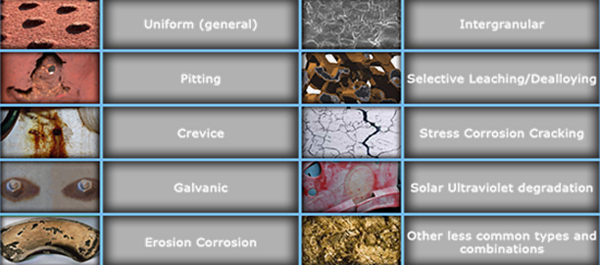
Table 1: Common Depictions of Corrosion
Photo credit: D, CPO
Above Ground Facilities
Above ground facilities represent a huge collection of categories and include:
- Electrical Distribution Systems (see next section)
- Water lines and associated valves, pumps, and treatment
- Water storage tanks
- Fuels related facilities (see the POL Storage and Distribution Knowledge Page)
- Towers
- Support structures
- Heating ventilating and cooling equipment (HVAC)
- HVAC Units
- Cooling Towers
- Packaged Outdoor Units
- Treatment Plants:
- Water
- Wastewater
- Industrial Waste
- Generation Plants
- Central Steam
- High Temperature Hot Water (HTHW)
- Electric
Electrical Distribution Systems
Electrical distribution systems have many components that are susceptible to corrosion and thus must be protected and maintained to ensure safe and reliable operation. These at-risk components include:
- Timber, concrete, and steel poles for above ground distribution lines and lighting
- Steel transmission towers and tower footings
- Guy anchors
- Grounding systems
- Substations
- Electric Supply Stations
- Transformers (above ground and submersible)
- Cable, wire, and conductors
- Conduits and duct banks
- Manholes
- Electrical panels
- Switch Gear and Protection Devices
There are hundreds of thousands of transmission towers in the U.S. These poles and lattice work of galvanized steel typically range from 50 to 180 feet in height. The Department of Energy reports that 70% of the power grid's transmission lines and power transformers are over 25 years old, with parts of the current network more than a century old. In a medium atmospheric severity (ISO Classification C3), galvanized transmission towers and poles can stay in service for 20 to 35 years before showing the first signs of corrosion. Once a galvanized transmission tower or pole begins to corrode, the corrosion advances exponentially. A tower or pole with less than 5 percent rust at age 30 can oxidize to the point of failure within 10 years. Recognizing the industry's need for guidance in developing maintenance programs, AMPP and IEEE developed standards that target the needs of the electric power utility sector.
To resist decay from insects and fungi, timber poles must be pressure treated full length with chromated copper arsenate or ammoniacal copper arsenate according to AWPA U1. Cuts and bores in timber poles should be done prior to treatment.
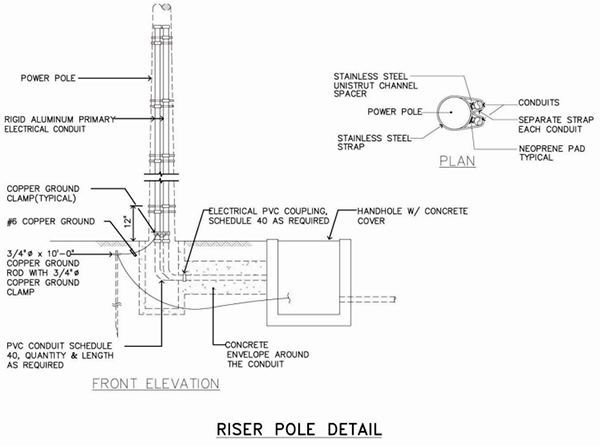
Figure 1: Riser Pole Design Details (note the above ground and below ground transition along with the identification of specific corrosion resistant materials)
Figure Source: Marianas Design and Construction Standards, 2017
Major corrosion factors for electrical distribution systems include:
- Atmospheric corrosion on above ground structures
- Soil corrosive properties and stray currents for buried or submerged structures
- Insect and fungi attack on timber distribution poles
- Dissimilar metal usage and non-compatible materials
- High current densities at bonding and grounding locations
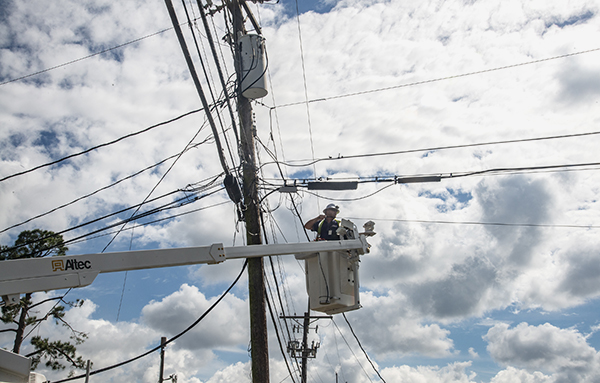
Photo 1: Hurricane Ida-Metairie Utility Restoration
Photo Source: FEMA
Design And Durability Issues
Corrosion of utilities can occur on exterior surfaces due to atmospheric effects (see Photo 2) and submerged conditions such as soil corrosivity. Interior corrosion can severely degrade components such as pipes, conduits, tanks, vaults, pipe hangars and supports (see Photo 3).
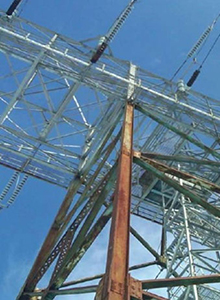
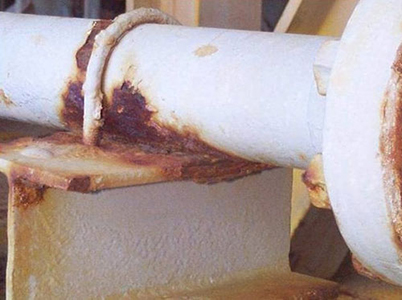
Photo 2: Tower Support Corrosion
Photo Source: DCPO
Photo 3 Above Ground Support, Bold and Flange Corrosion
Photo Source: DCPO
Typical utility components at risk identified in the Vision Point Systems Study: Corrosion Factors in DoD Facilities (October 2014) include:
- Electrical panels, breakers, cabinets, transformers, poles, and metal conduits
- Piping (steam and condensate piping leaks, water lines deterioration, rusted pipes)
- Heating Ventilation and Air Conditioning Components (HVAC) including towers, chillers, outside air intakes, vent stacks, brackets, ventilation turbines
- Waste-water plants (utility building, sewage treatment, sewage lift stations, piping, elbows, chains, bolts, conduits, air tank, jib crane, pressure regulators)
- Miscellaneous facilities (valves, light fixtures, fasteners)
- Internal piping/conduit corrosion impacts caused by water chemistry
Note that this Study attempted to clarify the LMI Facilities Cost of Corrosion Studies data and report available at that time. Vision Point attempted to provide an extensive explanation of facilities cost drivers, priorities and impacts, and did an excellent review and assessment with the data available. What is important from their work, is that this list of facilities is indicative of the high cost of corrosion for exterior facilities. It provides a good example of why a good Sustainment Management System (SMS) with reliable data collection, consistent data elements, and a good facilities inspection program is essential to keep track of CPC related deficiencies and mitigation. It is impossible to make a good decision about facilities sustainment if accurate information is not collected and maintained.
Environmental Severity Classification (ESC) is explained in the ESC Web Page and can be calculated for the specific location under consideration in the ISO Corrosivity Category Estimation Tool (ICCET) Toolbox. The UFC 1-200-01 DoD Building Code also provides a quick view of specific installation ESC Zone calculations (see appropriate appendix), although the designer should utilize the ICCET Tool for the most accurate "C" (C1 through C5) classification. If the ESC zone lies between C3 and C5 additional CPC material and location specific considerations must be applied. This includes the selection of more corrosion resistant coatings and materials consistent with that ESC Zone. Identifying the corrosive forces and employment of CPC design strategies include:
- Prevention of dissimilar metal corrosion
- Use of protective coatings, isolators, and corrosion inhibitors
- Consideration of alternate materials for components proximate to salt water and in areas of high environmental severity
- Prevention of entrapment of water and moisture intrusion
- Providing close attention to construction practices that can increase corrosion risks:
- Monitoring and having approvals for any field modifications and material substitutions
- Properly storing materials and preventing damage to coatings during storage and installation
- Ensuring that field cuts and cut edge corrosion are monitored and repaired
- Elimination of crevices that will retain/pond water and other liquids
- Reduction of rough and sharp surfaces
- Ensuring appropriate coating choice and application
- Quality control and oversight to ensure required welds
- Correctly installing gaskets and other features that would otherwise allow leakage and infiltration into the structure (pipeline, valves, access manhole, cathodic protection (CP) feature)
- Ensuring that foundations supporting above ground structures are protected from corrosive forces
- Attempting to alter the environment in order to reduce the risk of corrosion can be addressed by:
- Adjusting water chemistry in potable water systems
- Modifying areas around structures to provide adequate drainage
- Using organic based deicers in lieu of chloride based salts
- Relocating sources of stray currents
Cathodic Protection
Properly installed and maintained CP systems can reduce life cycle costs by extending a utility's lifecycle. These systems can also reduce the potential liability from premature failure of utilities, such as gas line explosions and jet fuel leaks, while also ensuring the avoidance costs associated with the leaks such as fines, environmental cleanup, remediation and disposal of contaminated soil, and monitoring requirements.
Common systems and structures requiring protective coatings specific for that use and CP regardless of soil or water corrosivity (with a focus on above ground sections):
- Liquid fuel piping
- Oxygen pipelines
- Fire mains and underground fire protection piping
- Fuel distribution and storage systems
- Potable water distribution systems
- Natural gas or propane distribution systems including metallic components of non-metallic lines
- Compressed gas distribution systems, such as air, oxygen, and nitrogen
- Fire protection water storage tanks, piping, or water lines
- Sewage tanks, lift stations, and effluent pipelines
- Cooling towers
- Elevated storage tank systems
- Systems with hazardous products
- Ductile iron pressurized piping under floor (slab on grade)
- Underground, ground level, and elevated storage tank systems
- Waterfront structures
- Reinforcing steel in concrete
- Exterior bottom of on-grade steel water storage tanks
- Other systems that may employ CP include potable water distribution systems, sewage lift stations, and compressed air distribution systems
Coatings and CP should most always be used in conjunction with each other for buried or submerged structures. Both are required by law for Underground Storage Tanks (UST) and certain Petroleum, Oil and Lubricant (POL) lines. For additional information on CP see the WBDG DoD Continuing Education Courses (login account required) and the Cathodic Protection Knowledge Area. See also CP assessment, design, installation and sustainment (UFC 3-570-01 Cathodic Protection and UFC 3-570-06 Operation And Maintenance: Cathodic Protection Systems).
Corrosion rates can be greatly accelerated when two or more dissimilar metals are in contact with each other, particularly when they are buried or submerged. Galvanic corrosion can effectively be eliminated or minimized by:
- Using as much of the same metal as possible
- Choosing metals close together in the galvanic series
- Placing a protective insulator between the two dissimilar metals
- Keeping the cathodic area small in relation to the anode area; for instance, bolts or screws of stainless steel for fastening aluminum sheets, but not the reverse
- Using special coatings on the metals, ensuring not to coat the anodes
Considering coating mechanisms for protection which may include the following:
- Barrier Protection—Protective coatings and linings attempt to isolate the structure from the environment (electrolyte)
- Cathodic Protection (CP)—Some protective coatings have a high loading of fine zinc particles. Once cured, the electrical contact between the particles and underlying steel provides a type of CP
- Inhibitive Pigments—Some pigments are added to primers to inhibit corrosion at the coating/metal interface
In the case of internal corrosion of a pipe, the anode, cathode, and conductive material are all found in the pipe wall while the electrolyte is the fluid transmitted within the pipe. For water distribution utilities the key parameters affecting internal pipe corrosion are:
- Water quality and composition (pH, Alkalinity, Dissolved Oxygen)
- Ferric scale
- Flow conditions
- Biological activity
- Disinfectants
- Corrosion inhibitors
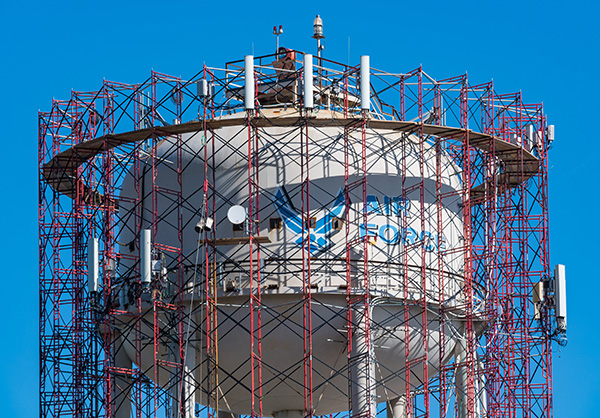
Photo 4: Dover AFB Water Tower Restoration
Photo Source: Roland Balk, 436th Airlift Wing PAO
Each of these facilities and equipment are exposed to the elements (exterior) and on the interior tend to be represent highly corrosive environments due to the chemicals used, liquids being treated and the heat and moisture that exacerbate corrosive conditions. Several guidance documents provide insights into corrosion risk mitigation:
- UFC 1-200-01 DoD Building Code
- UFC 1-300-02 Unified Facilities Guide Specifications (UFGS) Format Standard
- Marianas Navy and Marine Corps Design and Construction Standards (MDACS), Naval Facilities Engineering Command
- DoD Unified Facilities Criteria Program
Photos 4 through 6 show the corrosion challenges associated with keeping above ground facilities operational. Each facility and location, including micro-environments, that might exist around or within a structure provide their own challenges. Treatment plants can house extremely corrosive chemicals and atmosphere, which requires special attention to material selection, operations, and sustainment. Designers, engineers and sustainers have an essential responsibility to ensure that the facility that is designed and constructed meets life cycle expectations. Water storage towers require both interior and exterior coatings that meet water safety and quality requirements. Coating these structures is a big undertaking as can be seen in Photo 4. Selecting the correct materials will have a huge impact on reducing life cycle costs. See the Relevant Criteria Section below for more insights.
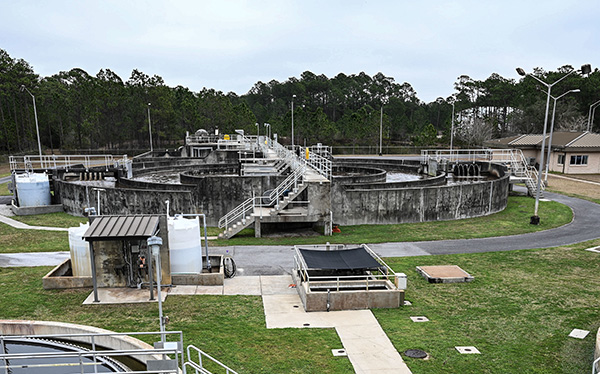
Photo 5: 1st SOCES Treats Wastewater at Hurlburt Field
Photo Source: Airman 1st Class Nathan LeVang, 1st Special Operations Wing Public Affairs
The Marianas Navy and Marine Corps Design and Construction Standards (MDACS), lists corrosion related guidance for corrosion in general and specifically for utility systems and exterior structures. Guam's hot humid climate requires special design, knowledge, material selection, mechanical design and construction methods to prevent corrosion problems, structural failure, and moisture problems, that could lead to costly repairs and lost use of facilities while repairs and mitigation are being performed.
While the following guidance is required in Guam for ESC Zones 4 and 5, designers, engineers and sustainers can gain understanding of what is required under those conditions and apply them to local situations where similar ESC Zones exist.
- Material selection is key to success in hot humid design.
- Exterior material coatings and surfaces must resist mold/moisture penetration and be self-cleaning through rainfall.
- Reinforced concrete is the structural material to be used unless otherwise indicated.
- Exterior metal framing, fasteners, and connections shall use properly selected stainless steel (or equal) corrosion protection.
- Exterior fasteners shall be stainless steel. Within interior conditioned spaces exposed steel elements at structural connections must be hot-dipped galvanized steel.
- For exterior walls paint or coatings shall have additional mildewcide additives for mold and mildew resistance. Design and finish surfaces to prevent dirt build up through selection of smooth or fine texture finishes, designing positive sloping surfaces to drain rain, and incorporating self- cleaning silicone enhancements to paints and coatings.
- Galvanized steel doors and frames shall be painted with high grade corrosion resistant automotive urethane finish over an epoxy primer over an etching primer.
- Overhead roll-up doors and door assemblies shall be hot dipped galvanized factory painted with highly corrosion resistant paint coating. Hardware and fasteners shall be stainless steel type 316. Metal door frames, tracks, angles, plates, torsion springs and accessories shall be hot dipped galvanized and painted.
- All exterior mechanical equipment shall be provided with corrosion protection including manufacturer's marine grade corrosion coating, type 316 stainless steel screws, and stainless-steel exposed parts/hardware.
- Air conditioning condenser coils shall be entirely coated with the manufacturer's standard corrosion resistant epoxy, vinyl coating, or phenolic coating.
For the exterior building envelope strength, durability (corrosion-resistance), humidity control, the ability to withstand typhoon winds and typhoon flying debris, and seismic resistance are some of the priorities in the design for exterior building envelope systems. Selected construction and finish systems shall reduce life-cycle costs and simplify maintenance.
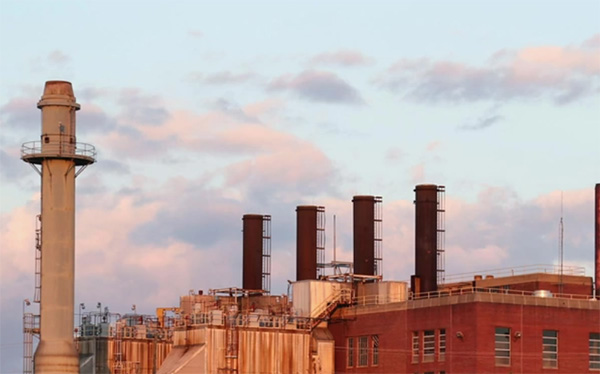
Photo 6: Camp Lejeune Steam Plant
Photo Source: Cpl. Evan Falls, Marine Corps Installations East
See the following CPC Knowledge pages for additional facilities specific information:
- Petroleum, Oil, and Lubricants (POL) Storage and Distribution Systems Knowledge Area
- Waterfront and Coastal Structures
- Piers and Wharves
- Aviation Facilities and Support Structures
- Corrosion Issues in Roofing Systems
- Doors
- Fencing
- Cathodic Protection
- Corrosion Science
- Paints and Coatings
- Fungi, Mold, and Mildew Corrosion Issues
- Corrosion Issues in Below Ground Utilities and Buried Structures
- CPC Checklists
- Facilities Corrosion Impacts on Operations and Mission
Relevant Criteria Highlights
The following is a representative list of some specific applicable UFC and UFGS and their highlights. For a more complete list of resources see the "Relevant Codes, Standards, and Guidelines" Section at the end of this page.
-
UFC 1-200-01 DoD Building Code provides very specific guidance for design, construction and sustainment actions related to CPC, especially in corrosion-prone locations. Corrosion-prone locations as defined in the UFC require a higher level of protection and are included below:
- Exterior exposed metallic elements at a location with an ESC of C3, C4, or C5.
- Exterior exposed nonmetallic elements at a location with an ESC of C4 or C5.
- Locations where microenvironmental factors (for example, prevailing winds, ventilation, waterfront environments, industrial emissions, deicing salt application, possible chemical splash/spillage, adverse weather events such as flooding or wind-driven rain, and penetrations of the building envelope) may create a locally corrosive environment regardless of ESC.
- Humid locations identified in ANSI/ASHRAE/IES 90.1 as climate zones 0A, 1A, 2A, 3A, 3C, 4C, and 5C.
- Appendix ESC for DoD Locations, identifies the ESC Zone for each of the DoD installations around the world, which then drives the selection of the types of materials and processes that should be used for corrosion-prone locations.
- The UFC requires the use of "materials that are resistant to, or protected from, ultraviolet radiation. High ultraviolet exposure results in rapid deterioration of most nonmetallic roof materials, paints, sealants, elastomeric coatings, and wood."
- Products should be designed "to prevent corrosion in applications where elevated temperatures are present. Elevated temperatures have adverse effects on building materials such as paints, woods, and many asphalt-based products. High temperatures combined with high humidity cause severe deterioration."
-
UFC 1-300-02 Unified Facilities Guide Specifications (UFGS) Format Standard defines standards for the use of UFGS. Requires when the selection of a material, component, or system for corrosion prevention, life cycle cost effectiveness, or durability depends on the location, application, conditions, or atmospheric and chemical environment. In the notes, provide direction on identifying and selecting those variables. Use International Organization for Standardization (ISO) 9223 and Environmental Severity Classification (ESC) factors, to help specify when to use materials, coatings, and other design elements in each project location or atmospheric environment. Additionally, provide direction on what item to use based on other relative criteria such as soil corrosivity, ultraviolet exposure, solar radiation, biological, or other factors causing deterioration of a material or its properties because of a reaction of that material with its chemical environment.
-
UFC 3-101-01 Architecture provides CPC and ESC guidance for architectural systems. See Change Record of Changes Summaries Section for specific details of recently added references. Highlights reasons to address corrosion and the impacts on total ownership costs. Provides specific direction on materials related to corrosion. Invokes UFC 1-200-01. The humidity conditions must also be considered during design; humid locations are those in ASHRAE climate zones 0A, 1A, 2A, 3A, 3C, 4C, and 5C (as identified in ASHRAE 90.1). Addresses mold, mildew, ESC, corrosion, prevention, deterioration, rot, humidity, coatings, lifecycle, degradation, durability, rust, and ultra-violet radiation (uV) risks.
-
UFC 3-190-06 Protective Coatings and Paints provides requirements and technical guidance for the effective use of paint-type coatings to protect common materials such as metal, concrete, pavements, gypsum board and wooden structures at military activities from deterioration. This UFC applies to all Navy, Air Force, and Army service elements and contractors. Requires paints and coatings that are durable and minimize the need for preventative and corrective maintenance over the expected service life of the component or system. Note that this is a significant update from previous versions. Different materials will be used based on local environmental conditions (See UFC 1-200-01 as required in the UFC). Corrosive environments, which require additional corrosion protection, are those project locations which have an Environmental Severity Classification (ESC) of C3, C4 or C5. Comply with ASHRAE humid location climate zones coating systems for specific use designations. Defines. Common systems and structures requiring protective coatings specific for that use:
- Steel Storage Tanks (Water, Fuel, Liquids)
- Steel Distribution Lines (Fuel, Water, Liquid)
- Communication Towers and Tall Structures
- Hot Steel Surfaces (Stacks)
- Concrete Fuel Tanks
-
UFC 3-230-01 Water Storage and Distribution provides requirements for typical storage, distribution and transmission systems for domestic water, fire protection and non-potable water for the Department of Defense (DoD). It specifically addresses corrosion in the context of soils, materials and construction, composites tanks, and coatings. Cathodic Protection (CP) is discussed.
-
UFC 3-230-02 O&M: Water Supply Systems provides technical guidance for operating and maintaining water supplies, treatment plants, storage facilities, and distribution systems at military installations. Applies to all personnel who are responsible for operation and maintenance fixed- base water systems. Provides insights into corrosion impacts, actions for prevention and control within the water supply system and components. Addresses CPC maintenance recommendations, CP, rust, coatings, and pitting risks.
-
UFC 3-230-03 Water Treatment provides requirements for typical water treatment systems for the DoD. These minimum technical requirements are based on UFC 1-200-01. Where other statutory or regulatory requirements are referenced in the contract, the more stringent requirement must be met. Addresses corrosion, cathodic protection, and corrosion control treatment requirements.
-
UFC 3-240-01 Wastewater Collection and Treatment provides requirements for typical wastewater collection systems for the DoD. These minimum technical requirements are based on UFC 1- 200-01. Where other statutory or regulatory requirements are referenced in the contract, the more stringent requirement must be met. Addresses soil corrosivity and materials utilized in wastewater collection systems. Corrosion, CP, and coating requirements are addressed.
-
UFC 3-240-13FN Industrial Water Treatment Operation and Maintenance provides an overview of industrial water treatment operations and management. "Industrial water" refers to the water used in military power generation, heating, air conditioning, refrigeration, cooling, processing, and all other equipment and systems that require water for operation. Industrial water is not the same as potable water. Industrial water is never consumed or used under situations that require a high degree of sanitation. Industrial water requires water preparation or chemical treatment, or both, to avoid the problems described in the UFC. Water preparation and chemical treatment requirements are described according to the type of system in question.
-
UFC 3-301-01 Structural Engineering requires use of ESC in design considerations and actions and defines and delineates corrosion risks in structures. Discusses specific material use and restrictions. Refers to UFC 1-200-01 requirements. Steel Structures in Corrosive Environments must "use designs that minimize the impact of corrosion." Addresses corrosion, ESC, deterioration, humidity, coatings, life cycle, deterioration, degradation, durability, sun exposure, mold, and mildew risks.
-
UFC 3-430-01FA Heating and Cooling Distribution Systems provides criteria and guidance for the design and construction of heating and cooling distribution systems and supplements information in the "Notes to the Designer" of the guide specifications. These distribution systems include above ground heat distribution systems. Covers multiple CPC topics such as corrosion-resistant materials, internal corrosion, cathodic protection, mold, and degradation.
-
UFC 3-430-08N Central Heating Plants contains MIL-HDBK-1003/6 Central Heating Plants. Provides criteria for designing steam and high temperature water central and individual heating plants. Covers many different CPC topics including economizer corrosion controls. General corrosion prevention requirements are addressed including cathodic protection, deterioration, coating, and pitting.
-
UFC 3-501-01 Electrical Engineering provides the governing criteria for electrical systems, explains the delineation between the different electrical-related UFCs, and refers to UFC 3-570-01 for CP requirements. UFC 3-501-01 should be used for design analysis, calculation, and drawing requirements. Provides technical requirements for general aspects of the electrical design of projects. Provides electrical engineering design and analysis criteria for design-build and design bid build projects. Provides top level minimum mandatory electrical requirements and refers to other applicable UFCs. Addresses some corrosion related requirements. Incorporates ESC requirements as referenced in UFC 1-200-01. The section on Corrosive and High Humidity Areas provides a lengthy explanation of corrosion related requirements invoking ASHRAE requirements as well. Specific materials are delineated. Addresses corrosion, cathodic protection, ASHRAE standards, paint, environmental, weather, humid conditions, corrosion resistant materials, weatherproof enclosures, stainless steel and aluminum use, and ESC.
-
UFC 3-550-01 Exterior Electrical Power Distribution provides policy and guidance for design criteria and standards for electrical power and distribution systems. The information provided here must be utilized by electrical engineers in the development of the plans, specifications, calculations, and Design/Build Request for Proposals (RFP) and must serve as the minimum electrical design requirements. It is applicable to the traditional electrical services customary for Design-Bid-Build construction contracts and for Design-Build construction contracts. Project conditions may dictate the need for a design that exceeds these minimum requirements. The section on "Environmental Severity and Humid Locations" requires that "In corrosive and humid environments, provide design detailing, and use materials, systems, components, and coatings that are durable and minimize the need for preventative and corrective maintenance over the expected service life of the component or system." It invokes "UFC 1-200-01 and identifies corrosive environments and humid locations requiring special attention." Addresses corrosion, ESC, coatings, environmental conditions, humid and humidity, and corrosion prevention.
-
UFC 3-570-01 Cathodic Protection (CP) provides policy and design requirements for CP systems. The UFC provides the minimum design requirements, and must be utilized in the development of plans, specifications, calculations, and Design/Build Request for Proposals (RFP). Note that UFC 3-501-01, Electrical Engineering, provides the governing criteria for electrical systems, explains the delineation between the different electrical-related UFCs, and refers to UFC 3-570-01 for CP requirements. UFC 3-501-01 Electrical Engineering should be used for design analysis, calculation, and drawing requirements.
-
UFC 3-570-06 Operation and Maintenance: Cathodic Protection Systems provides guidance for operation and maintenance of CP systems including the elements of a good CP program. It should be used by field personnel to perform scheduled inspections and preventive maintenance and to troubleshoot and repair CP systems. Information on non-routine field measurements is also included to enable technical assistance personnel to troubleshoot problems beyond the normal capability of field personnel to isolate or correct. Delineates mandatory CP systems use.
-
UFC 3-600-01 Fire Protection Engineering For Facilities requires that above ground piping and embedded pipe utilized in fire-protection systems be corrosion-resistant (ASTM A312). For service mains and laterals, "provide appropriate corrosion protection based upon pipe materials and the corrosive properties of the water supply and earth."
-
UFGS 09 90 00 Paints and Coatings addresses "requirements for painting of new and existing, interior and exterior substrates." Discusses corrosion and invokes UFC 1-200-01. Delineates ESC requirements for ESC Zones C3, C4 and C5 and ASHRAE 90.1 humid locations climate zones 0A, 1A, 2A, 3A, 4C and 5C. It includes contractor qualification requirements (SSPC QP 1, QP 2, etc.) and refers to SSPC, NACE, and MPI Standards. Topics include coatings, corrosion, rust, deterioration, mold, and mildew.
-
UFGS-09 96 00 High-Performance Coatings provides guidance on "special coatings […] required for harsh indoor locations or operations (any area subjected to chemical and/or abrasive action), and all outdoor installations." Requires the use of epoxy resin coatings where surface coatings require high corrosion resistance, chemical resistance, bond strength, UV resistance and toughness. It requires compliance with MPI Standards in the MPI Approved Products List and the MPI Architectural Painting Specification Manual prior to the start of any project. A skilled applicator requirement for coating application is included. Degradation, coatings, corrosion, rust, and ultraviolet topics are addressed.
-
UFGS-09 96 59 High-Build Glaze Coatings delineates the requirements for epoxy-polyamide, polyurethane, and epoxy polyester high performance, architectural wall coating systems for interior and exterior surfaces. Addresses surface preparation to prevent corrosion.
-
UFGS-09 97 13.16 Interior Coating of Welded Steel Water Tanks "covers the requirements for polyamide epoxy coating system[s] for interior of newly constructed Navy and Air Force water tanks, potable and non-potable, where shop applied coatings are not being considered." It addresses contractor qualifications and experience (SSPC QP 5, SSPC C-7). While it does not directly address ESC requirements, it does invoke UFC 1-300-02. Designers are encouraged to contact the AFCEC Corrosion Engineer and NAVFAC Atlantic with questions and clarification of the UFGS guidance.
-
UFGS 09 97 13.25 Maintenance, Repair, and Coating of Tall Antenna Towers includes the requirements for coating new and repairs to existing steel towers. Has multiple references to corrosion and processes to reduce corrosion. The UFGS addresses contractor qualifications and experience (SSPC QP 2). Requires a NACE qualified Corrosion Engineer. Discusses corrosion and invokes UFC 1-300-02.
-
UFGS 09 97 13.27 High Performance Coating for Steel Structures "covers the requirements for using zinc-rich epoxy/epoxy/polyurethane coating systems for exteriors of new Navy and Air Force steel structures, such as fuel tanks, water tanks, [and] above ground piping." Extensive notes at the beginning of the UFGS describe special requirements and recommendations. Contractor qualifications and certifications include SSPC PCS and SSPC QP 5. Invokes UFC 1-300-02. Note that designers are encouraged to contact the AFCEC Corrosion Engineer and NAVFAC Atlantic with questions and clarification of the UFGS guidance.
-
UFGS-09 97 13.00 40 Steel Coatings provides guidance on "the requirements for coating systems, materials, surface preparation, and application of protective coatings on carbon steel." Invokes UFC 1-300-02.
-
UFGS 23 52 30.02 10 Central Steam Generating System - Combination Gas and Oil Fired provides extensive guidance on providing corrosion protection.
-
UFGS 23 65 00 Cooling Towers and Remote Evaporatively-Cooled Condensers provides extensive guidance on preventing corrosion through the selection of corrosion resistant materials and coatings.
-
UFGS 26 11 14.00 10 Main Electric Supply Station and Substation covers the requirements for main electric supply stations or substations having a nominal voltage class of 15 kV up to 115 kV. Discusses corrosion resistant materials selection and protection requirements. The UFGS discusses corrosion protection and resistance, coatings, paints, primers, and humidity control.
-
UFGS 26 12 19.10 Three-Phase, Liquid-Filled Pad-Mounted Transformers covers the requirements for three-phase pad-mounted, liquid-filled transformers of the dead-front and live-front types for exterior applications. Under "Corrosion Protection" users are directed to use stainless steel bases and cabinets for most applications. In highly corrosive environments, the additional cost of totally stainless-steel tanks and metering enclosures may be justified. Manufacturer's standard construction material is acceptable only in noncoastal and noncorrosive environments. Choose the second bracketed option for project locations with Environmental Severity Classifications (ESC) of C4 and C5. The UFGS discusses coatings, corrosion, degradation, ESC, stainless steel tanks and metering enclosures, temperature and humidity.
-
UFGS 26 42 15 Cathodic Protection System for the Interior of Steel Water Tanks covers the requirements for steel water tank cathodic impressed current systems (impressed current or galvanic anodes). Requires NACE certifications. Detailed guidance is provided for each military service engineering organization's requirements.
-
UFGS 26 56 00 Exterior Lighting discusses corrosion resistant materials selection and protection requirements for aluminum poles, steel housings for capacitors, as well as factory applied finish requirements.
-
UFGS 26 56 13.00 40 Lighting Poles and Standards covers the requirements for lighting poles, standards, and related mounting accessories for exterior lighting, including, but not limited to, area lighting, flood lighting, roadway lighting, and security lighting systems. Requires corrosion resistant aluminum alloys finish for poles. Grounding rod material and corrosion requirements are specified.
- UFGS 33 71 01.00 40 Overhead Transmission and Distribution describes the requirements for corrosion resistant coatings, fittings and materials. Requires use of UFGS 09 90 00 Paints and Coatings to address field applied painting. Components requiring corrosion resistance includes connectors and splices, hardware, transformer tanks and covers, and finishes. In corrosive environments, galvanized steel pole-line hardware may not be acceptable and only hot-dip galvanized malleable or ductile iron should be permitted. The UFGS addresses corrosion, deterioration, finishes, coatings, degradation, ESC, galvanized steel poles, and hot-dip galvanized treatment.
It is recommended that the designer carefully review each criteria document to ensure that the appropriate materials are selected and placed in service along with the associated processes. Note that while a UFC or UFGS might not directly require corrosion related protection both UFC 1-200-01 and UFC 1-300-02 does require the application of the appropriate ESC Zone with the associated material selection and design requirements.
Utilities System Sustainment, Restoration, and Modernization (SRM) Insights
Understanding Corrosion Science (see Corrosion Science Knowledge Area) as it affects above ground utilities and associated structures will help the designer and SRM manager make decisions that create facilities that are life cycle cost effective and more durable. See Figures 2 and 3 for sustainment program flowcharts and considerations. The use of BUILDER™ Sustainment Management System (SMS) provides for the creation of a database, assessment and maintenance management of facilities assets.
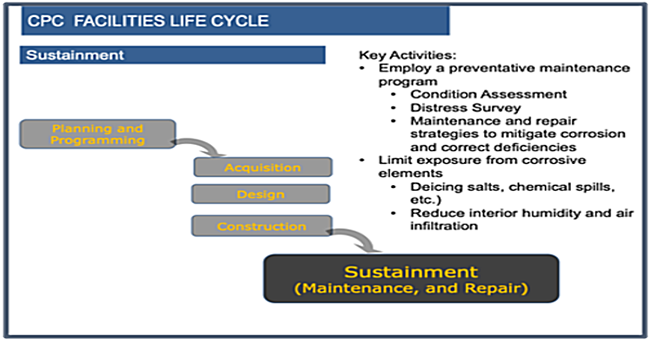
Figure 2: CPC Facilities Life Cycle (Design Service Life)
Source: Steve Geusic, P.E.
Figure 3 illustrates the sustainment process and the associated workflow. Identifying and tracking building system deficiencies through this process will ensure that the necessary work will be scheduled and accomplished in a timely process. The broad area of Above Ground Utilities and Related Structures presents a long list of challenges for the facilities manager. This diverse range of facilities must be represented accurately in any SMS and along with the associated inspections, preventative maintenance, and SRM actions to keep them operational. The alternative to having a good, responsive sustainment program for below ground utilities and buried structures is "break down maintenance" which is never good and always drives last minute decisions and actions. This usually results in costly repairs, rather than ensuring that system sustainment decisions and repairs are accomplished in a more cost-effective manner over time.
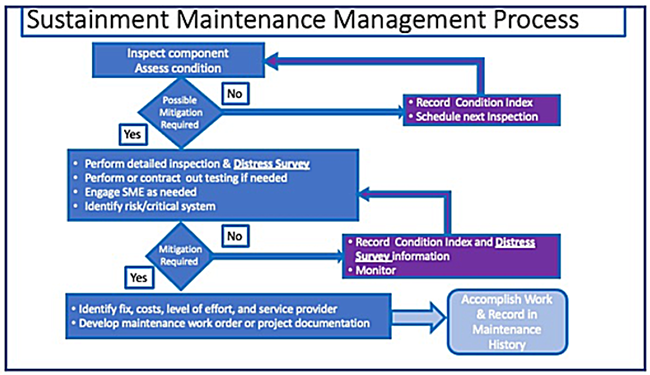
Figure 3: Sustainment Maintenance Management Process
Source: Steve Geusic, P.E.
For more insights into CPC sustainment management see the CPC in Operations and Maintenance (O&M), and, Sustainment, Restoration, and Modernization (SRM) resource page. Additional information is provided on SMS, Builder™, and CPC data collection.
Lessons Learned and Input From The Field
- Consistent with DoD Directive 4270.5 Military Construction, utilize the CPC criteria and information hosted on the Whole Building Design Guide including UFC, UFGS, and Service Level facilities guidance. If necessary, mark-up guide specifications (e.g., UFGS) with prescriptive CPC requirements.
- Include sufficient funds for CPC materials and coatings that are life cycle cost effective, appropriate for the environment where the project is located, and able to reach the intended service life without extensive preventative or corrective maintenance
- Include maintainability topics in the discussions with designers, constructors and SRM personnel
- Coordinate utility work with utility owners to include off-base power, water, waste and communications providers and obtain "dig permits" to ensure minimizing the risk to existing buried structures and the associated distribution systems
- Discuss corrosion prevention at the design/construction kick-off meeting and implemented on the plans at each submittal stage
- Turnover the most up to date utilities and related structures as-built drawings in the e-OMSI package [UFGS 01 78 24.00 20] from the Construction Agent with CPC related mark-ups
- Review and coordinate projects by a committee of public works design and maintenance, safety, environmental, and security to ensure projects are fully coordinated and maintainable before work begins
- Engage design and sustainment personnel in CPC decision-making activities, such as acquisition, design, inspection, maintenance, and repair
- Ensure that sustainment personnel have appropriate training and qualifications prior to turnover (See CPC Source Competencies and CPC Source Training for additional insights)
- Use aggressive preventive maintenance inspection programs that ensure early detection of deficiencies and reduce corrosion deterioration
- Maintain and check CP systems based upon recommended cycles
Summary
The following recommendations and links to content will help in the management of corrosion in above ground and utilities and related structures:
- Incorporate good Design Geometrics
- Select and leverage the appropriate ESC Zone Requirements
- Ensure that the design component or assembly complies with the requirements from the RFP, including performance technical specifications, referenced UFC and UFGS documents and the design
- Ensure that design drawings and specifications address CPC through proper choice of materials, CP, and coatings
- Select and specify materials and coatings that have low life cycle costs, are durable, and minimize the need for preventative and corrective maintenance
- Understand that initial investments in corrosion prevention are typically more life-cycle cost (LCC) effective than maintenance, repair, and replacement of prematurely degraded components
- Design and specify above ground utility structure components to reach the intended service life, including the use of enhanced materials, coatings, and applying CP for at risk structures in severe corrosive environments
- Select and execute design criteria based upon the facility requirement and the environmental conditions that exist at the facility location (see UFC 1-200-01 and the Corrosion Toolbox)
- Review the Importance of including Corrosion in the Planning Process page to gain facilities CPC planning insights
- Leverage CPC the acquisition insights into contract development and management from the Corrosion Prevention and Control Acquisition Issues page; these acquisition basics will help the Facilities Professional navigate key acquisition requirements and pitfalls in the process of achieving a successful CPC contract.
- Apply insights into design and construction issues from the CPC Design and Construction Issues page.
- Ensure that SRM processes, procedures and data collection are accomplished throughout the life cycle
- Utilize insights from the Facilities Corrosion Impacts on Operations and Mission table and the Corrosion Prevention and Control (CPC) in Operations and Maintenance (O&M), and, Sustainment Restoration and Modernization (SRM) page
- Refer to the CPC Checklists page and associated Checklists Tools page for a quick reference into project development, planning, project management, evaluation, and CPC technical details
Additional Resources
Whole Building Design Guide
Unified Facilities Criteria (UFC)
- UFC 1-200-01 DoD Building Code
- UFC 1-300-02 UFGS Format Standard
- UFC 3-190-06 Protective Coatings and Paints
- UFC 3-230-01 Water Storage and Distribution
- UFC 3-230-02 O&M: Water Supply Systems
- UFC 3-230-03 Water Treatment
- UFC 3-240-01 Wastewater Collection and Treatment
- UFC 3-301-01 Structural Engineering
- UFC 3-420-01 Plumbing Systems
- UFC 3-420-02FA Compressed Air
- UFC 3-430-09 Exterior Mechanical Utility Distribution
- UFC 3-501-01 Electrical Engineering
- UFC 3-550-01 Exterior Electrical Power Distribution
- UFC 3-555-01N 400 Hertz Medium Voltage Conversion/Distribution and Low Voltage Utilization Systems
- UFC 3-570-01 Cathodic Protection
- UFC 3-570-06 Operation And Maintenance: Cathodic Protection Systems
- UFC 3-575-01 Lightning and Static Electricity Protection Systems
- UFC 3-580-01 Telecommunications Interior Infrastructure Planning and Design
- UFC 3-600-01 Fire Protection Engineering For Facilities
- UFC 4-150-02 Dockside Utilities For Ship Service
- UFC 4-151-10 General Criteria For Waterfront Construction
Unified Facilities Guide Specifications (UFGS)
- UFGS 01 78 24.00 20 Facility Electronic Operations And Maintenance Support Information (eOMSI)
- UFGS 09 90 00 Paints and Coatings
- UFGS 09 96 00 High-Performance Coatings
- UFGS 09 97 13.00 40 Steel Coatings
- UFGS 09 97 13.25 Maintenance, Repair, and Coating Of Tall Antenna Towers
- UFGS 09 97 13.27 High Performance Coating for Steel Structures
- UFGS 13 34 19 Metal Building Systems
- UFGS 22 33 30.00 10 Solar Water Heating Equipment
- UFGS 23 52 30.02 10 Central Steam Generating System - Combination Gas and Oil Fired
- UFGS 23 58 00.00 10 Central Steam Heating and Utilities Systems
- UFGS 23 65 00 Cooling Towers and Remote Evaporatively-Cooled Condensers
- UFGS 23 74 33.00 40 Packaged, Outdoor Heating and Colling Makeup Air-Conditioners
- UFGS 26 11 13.00 20 Primary Unit Substation
- UFGS 26 11 14.00 10 Main Electric Supply Station and Substation
- UFGS 26 42 13 Galvanic (Sacrificial) Anode Cathodic Protection (GACP) System
- UFGS 26 42 15 Cathodic Protection System for the Interior of Steel Water Tanks
- UFGS 26 42 17 Impressed Current Cathodic Protection (ICCP) System
- UFGS 26 56 00 Exterior Lighting
- UFGS 33 05 16 Concrete Poles
- UFGS 33 11 00 Water Utility Distribution Piping
- UFGS 33 11 23 Natural Gas and Liquid Petroleum Piping
- UFGS 33 16 13.16 Wire-Wound Circular Prestressed-Concrete Water Tank
- UFGS 33 16 15 Water Storage Steel Tanks
- UFGS 33 30 00 Sanitary Sewerage
- UFGS 33 40 00 Storm Drainage Utilities
- UFGS 33 63 13 Exterior Underground Steam Distribution System
- UFGS 33 71 01.00 40 Overhead Transmission and Distribution
- UFGS 33 73 00.00 40 Utility Transformers
- UFGS 33 75 00.00 40 Switchgear and Protection Devices
- UFGS 33 77 19.00 40 Medium-Voltage Switch
- UFGS 33 77 36.00 40 Medium-Voltage Utility Fuses
Whole Building Design Guide Resources
- CPC Source Training
- WBDG DoD Courses
- Federal Facility Criteria—Extensive electronic library of construction guide specifications, manuals, standards and many other essential criteria documents
- Unified Facilities Criteria—Master list of UFCs
- Unified Facilities Guide Specifications—Master list of UFGSs
- Unified Master Reference List (UMRL)—Lists publications/Industry criteria referenced in UFGSs
- Marianas Navy and Marine Corps Design and Construction Standards (MDACS), Naval Facilities Engineering Command
- Public Works Utilities Criteria (PWUC) For Design and Construction: Electric, Water and Sewer, NAVFAC Marianas, Naval Facilities Engineering Command
- CPC Source Criteria
- Architectural Painting Specification Decision Tree
- Facilities Environmental Severity Classification Study Report
- Corrosion Checklists
- Corrosion Toolbox
- Corrosion Factors in DoD Facilities, Vision Point Systems
- The Whole Building Design Guide Corrosion Prevention and Control Source
- WBDG Waterfront Facilities
- USACE Learning Center
DoD Facilities Organizations
- Office of the Assistant Secretary of Defense for Construction
- Engineer Research and Development Center, Construction Engineering Research Laboratory (ERDC-CERL)
- Air Force Civil Engineer Center (AFCEC)
- Naval Facilities Engineering and Expeditionary Warfare Center (NAVFAC EXWC)
Industry Resources
- IEEE 1617-2007 "Guide for Detection, Mitigation, and Control of Concentric Neutral Corrosion in Medium-Voltage Underground Cables," Section 6
International Organization for Standardization
- ISO 9223:2012 Corrosion of metals and alloys—Corrosivity of atmospheres—Classification, determination and estimation
- ISO 9224:2012 Corrosion of metals and alloys—Corrosivity of atmospheres—Guiding values for the corrosivity categories
- ISO 9226:2012 Corrosion of metals and alloys—Corrosivity of atmospheres—Determination of corrosion rate of standard specimens for the evaluation of corrosivity
American Water Works Association
- AWWA Manual M27 External Corrosion Control for Infrastructure Sustainability
- NACE SP0315-2015/IEEE STD 1835 Standard for Atmospheric (Above Grade) Corrosion Control of Existing Electric Transmission, Distribution, and Substation Structures by Coating Systems
Water Environment Federation (WEF)
- Design of Wastewater and Stormwater Pumping Stations, Manual of Practice FD-4
- Design of Municipal Wastewater Treatment Plants, Manual of Practice MOP-8
Organizations
- The Association for Materials Protection and Performance (AMPP)
- American Institute of Steel Construction (AISC)
- American Iron and Steel Institute (AISI)
- ASME International (ASME)
- American National Standards Institute (ANSI)
- American Society of Civil Engineers (ASCE)
- American Society for Testing and Materials (ASTM)
- American Welding Society (AWS)
- American Water Works Association (AWWA)
- Foundation for Cross-Connection Control and Hydraulic Research (FCCCHR)
- International Organization for Standardization
- International Zinc Association
- Institute of Electrical and Electronics Engineers (IEEE)
- National Electrical Manufacturers Association (NEMA)
- National Fire Protection Association (NFPA)
- Underwriters Laboratories (UL)
- Water Environment Federation








